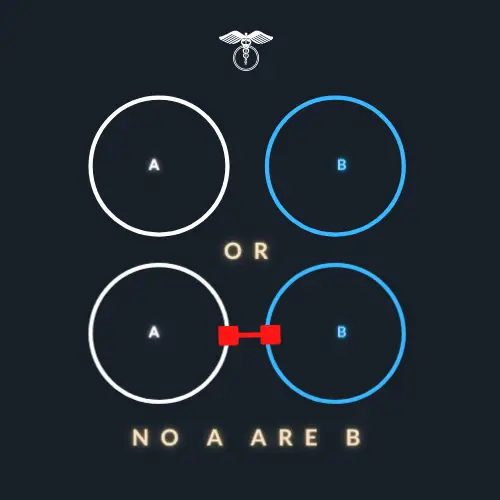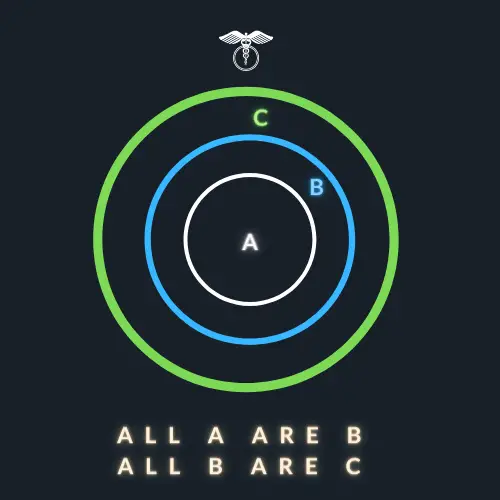Syllogism are a common question type you might encounter. In essence, a syllogism is simply a set of rules from which certain inferences can be drawn from.
It also might be the case that there isn’t sufficient information to safely conclude something from a syllogism.
Luckily, there are a distinct set of primitive rules you can use to interrogate more complex syllogisms. Let’s look at them!
Importance of Venn diagrams
It is important that you appreciate the importance of Venn diagrams when answering syllogism-based questions.
They help visualise the problem in a simple manner and can be an incredible help when interrogating questions quickly in time-constrained environments.
Each primitive rule has its own Venn diagram structure so it is important you memorise these and use them during your practice to improve your timings.
With each primitive rule, draw out the Venn diagram and learn exactly what follows given the rule!
I like to split up my syllogism practice into basic and complex primitives. Let’s get started.
Basic Primitives
Basic primitives are my own coining of what are the basic structure of categorical syllogisms. Learn this and you will have a deeper understanding and appreciation for the more complicated syllogism structures.
Some A are B
A simple diagram, some A are B is essentially telling us there is overlap between A and B. The word some, however, is a tricky thing, as it could mean a small minority, a narrow majority, or just 100% of A are B. We don’t know the full relationship between A and B and therefore All A could in fact be B! However your main focus should be on the valid assumptions you can draw.
Housekeeping for valid assumptions
Valid assumptions are simply assumptions that aren’t precluded by the statements we already have.
Valid Assumptions
- Some A are B (Statement)
- Some B are A
- Some B are not A
- Some A are not B
Venn

Some A are not B
This is essentially a rehashing of the first, from the perspective of the non-overlapping area.
Valid Assumptions
- Some A are not B (Statement)
- Some A are B
- Some B are A
Venn

All A are B
Another simple diagram that is telling us that B encapsulates all that is A. This is a very common pattern and is often aggregated with other rules to create complex questions.
Valid Assumptions
- All A are B (Statement)
- Some A are B
- Some B are A
Venn

No A are B
No relationship between A and B is disclosed, and therefore there is no overlap. This is also often denoted by a line between the 2 circles to ensure you are aware there is no interaction!
Valid Assumptions
- No A are B
- No B are A
Venn

Complex Primitives
These are aggregates of the simple primitive syllogisms we saw earlier.
This is what you are likely to encounter in your exams as these require you to draw more complicated Venn diagrams, and can truly test your understanding of syllogisms.
Some A are B and All B are C
Valid Assumptions
Venn

All A are B and Some B are C
Valid Assumptions
Venn

All B are A and all C are A
Valid Assumptions
Venn

All A are B and no B are C
Valid Assumptions
Venn

All A are B and no A are C
Valid Assumptions
Venn

Some A are B and no B are C
Valid Assumptions
Venn

All A are B and All B are C
Valid Assumptions
Between A and B:
- All A are B
- Some A are B
- Some B are A
Between B and C:
- All B are C
- Some B are C
- Some C are B
Between A and C:
- All A are C
- Some A are C
- Some C are A
Venn

Some A are B and Some B are C
Valid Assumptions
Between A and B:
- Some A are B
- Some B are A
Between B and C:
- Some B are C
- Some C are B
We are unaware of the relationship between A and C since we have no statements. However, we can’t exclude the possibility of some A being C, and some C being A
Venn

Summary
Syllogisms are an integral part of any decision making exam, and are worth up to 2 points in the UCAT exam.
You do have to get all 5 portions of the question correct which might not be worth it timewise, but if you are able to interrogate them quick enough, it is definitely a way to scoop up some easy points, instead of wasting time on the more time-constrained questions.
Remember the UCAT is a test in triage!
Snappy Syllogism is in development to help you practice all syllogism at speed!
**This page is continually being updated.**
